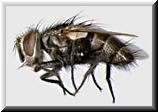Reared specimens examined. None.
Lespesia is a rather large genus with 28 species recognized in the Nearctic region (Wood 1987) and 13 species known from Canada (Sabrosky and Arnaud 1965, CNC). The Nearctic species were revised by Beneway (1963) and a revised key to the species of the region was published by Sabrosky (1980).
Published records of Lespesia parasitizing bertha armyworm are few. Wylie (1979) found eight bertha armyworm larvae parasitized by L. archippivora (Riley) in 1976 during a field study near Winnipeg, Manitoba and Turnock (1984) listed Lespesia sp. as a parasitoid of this host in Alberta. Most likely both records refer to L. archippivora. This species is wide ranging and common, and one of the few Lespesia species that is highly polyphagous (Sabrosky 1980). Its parasitism of bertha armyworm is evidently rare. It was not possible to verify the identification of this species because no specimens of Lespesia reared from bertha armyworm were located during this study. Lespesia archippivora is generally cited under the genus Frontina or Achaetoneura in literature prior to Beneway's (1963) revision of the genus.
Recognition. Lespesia can be recognized by eye almost bare (most species), parafacial bare, facial ridge with single row of setae of nearly uniform size along 1/3 to 2/3 of length, prosternum haired, first postsutural supra-alar seta at least as long and stout as first postsutural dorsocentral seta, mesonotum with 4 black vittae, katepisternum with four setae, anterodorsal setae on hind tibia forming an even row (with or without a longer seta near middle), vein M ending in wing margin forward of wing tip, and median discal setae absent from abdominal terga 3 and 4.
Lespesia archippivora is characterized within the genus (see Sabrosky 1980) by parafacial and parafrontal gray pruinose, 2 (not 1) reclinate fronto-orbital setae on each side, abdomen predominantly black (not mostly reddish), abdominal tergum 5 dull and pruinose (not shiny black on distal 2/5 to half), median marginal setae present on syntergite 1+2 (weaker in female); male with claws and pulvilli short (shorter than last tarsomere), frons at vertex obviously much wider than an eye; female with frons at vertex 1.25-1.35 times width of eye. Typical length is 5-7 mm.
The puparium of Lespesia archippivora was described and illustrated by Greene (1922) under the name Frontina archippivora.
Biology. Lespesia archippivora is a polyphagous tachinid recorded from a tenthredinid sawfly and many species of Lepidoptera, representing the following families: Arctiidae, Citheroniidae, Danaidae, Geometridae, Lycaenidae, Noctuidae, Notodontidae, Nymphalidae, Papilionidae, Pieridae, Pyralidae and Yponomeutidae (Arnaud 1978). Included among the hosts are such economically important crop pests as fall armyworm, Spodoptera frugiperda (J.E. Smith); beet armyworm, Spodoptera exigua (Hübner); cabbage looper, Trichoplusia ni (Hübner); imported cabbageworm, Pieris rapae (L.); and cotton bollworm, Heliothis zea (Boddie). In a survey of tachinids reared from lepidopterous larvae in Arizona (Butler 1958), L. archippivora was found to be both the most abundant species in crop situations and the one with the widest host range.
Adult females of Lespesia archippivora oviposit incubated eggs directly on the integument of their hosts (Bryan et al. 1968). Eggs hatch within 20 minutes and the host's integument is penetrated shortly thereafter. Multiple larvae can develop in a single host, with as many as 17 reported (Bryan et al. 1968). Lespesia species generally overwinter as larvae within the pupae of their hosts (Schaffner and Griswold 1934) and this habit may apply to L. archippivora in bertha armyworm as well.
Schaffner and Griswold (1934) record flight activity as "May, June to October" for the northeastern United States while Beneway (1963) cites highest flight activity north of the 38th parallel between July and September. Schaffner and Griswold (1934) report two or three generations per year.
Distribution. British Columbia to Ontario, south to California, southern Mexico and Florida (Beneway 1963).


